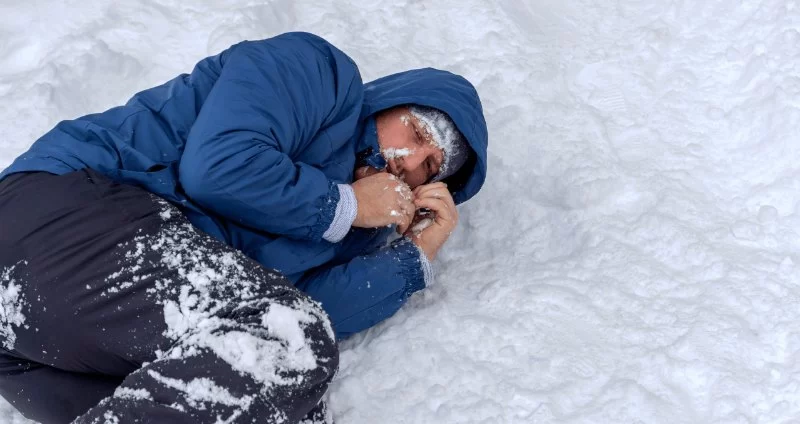- understanding-hypothermia-in-cold-water - Understanding Hypothermia in Cold Water
- early-signs-you-should-never-ignore - Early Signs You Should Never Ignore
- case-study-an-ice-fishing-trip-that-went-wrong - Case Study: An Ice Fishing Trip That Went Wrong
- immediate-steps-to-take-if-you-or-someone-else-is-affected - Immediate Steps to Take If You or Someone Else Is Affected
- preventive-measures-before-entering-cold-water - Preventive Measures Before Entering Cold Water
- get-support-and-outdoor-safety-resources-from-pine-cliff-resort - Get Support and Outdoor Safety Resources from Pine Cliff Resort
1. Understanding Hypothermia in Cold Water
Hypothermia is a potentially life-threatening condition that occurs when the body loses heat faster than it can produce it. In cold water, this process accelerates rapidly. Even in water as "warm" as 60°F (15.5°C), hypothermia can set in within an hour—and in near-freezing conditions, within minutes. The key factor is the body’s core temperature dropping below 95°F (35°C), which impairs organ function and mental awareness.
Unlike land-based cold exposure, cold water pulls heat from the body 25 times faster. That’s why understanding how to deal with hypothermia in cold water is not just for outdoor adventurers—it’s a critical skill for anyone who swims, boats, or fishes year-round.
2. Early Signs You Should Never Ignore
2.1 Shivering and Clumsiness
Shivering is your body’s first response to cold, trying to generate heat. But when shivering becomes uncontrollable or stops altogether, it’s a red flag. Alongside that, watch for fumbling hands or uncoordinated movement—classic symptoms of hypothermia's early stages.
2.2 Slurred Speech and Confusion
As core temperature drops, brain function slows. A person may slur their words, forget where they are, or become irrational. These are signs that hypothermia is progressing fast, and immediate action is required.
2.3 Skin Appearance
Cold, pale, or bluish skin—especially around the lips and extremities—is another major warning. It indicates poor circulation and a core temperature already slipping into dangerous territory.
3. Case Study: An Ice Fishing Trip That Went Wrong
In February 2024, a father and son from Wisconsin were ice fishing when a small crack in the ice gave way. The father fell into 33°F water and was only rescued 12 minutes later. Though he was wearing layered clothing, he wasn’t prepared for water immersion.
Despite immediate removal from the water, his symptoms quickly included slurred speech and unresponsiveness. Thanks to fast emergency response and rewarming techniques, he recovered—but it underscored how dangerously fast hypothermia develops. His survival was credited to wearing a flotation jacket and having a thermal blanket in their gear.
4. Immediate Steps to Take If You or Someone Else Is Affected
4.1 Get Out of the Water—Safely
The first priority is to remove the individual from the water. Do not exert extreme effort or sudden movement that may further drop their temperature or cause heart irregularities. Use floatation gear, ropes, or boards if needed.
4.2 Remove Wet Clothing
Wet clothes pull heat from the body. Carefully cut or peel them away and replace with dry, insulated layers if available. Cover the head and neck, which lose heat quickly.
4.3 Rewarm Gradually
Use body heat, warm (not hot) blankets, or warm water bottles placed on the neck, chest, and groin areas. Never use direct heat like a heating pad or open flame. And avoid giving hot drinks to someone with severe hypothermia—they may not be able to swallow safely.
4.4 Seek Emergency Help
Always call emergency services, even if the person seems to be improving. Internal damage from hypothermia can continue even after rewarming begins. Professional medical evaluation is essential.
5. Preventive Measures Before Entering Cold Water
5.1 Choose the Right Gear
Wetsuits or drysuits are essential for cold water activities. They slow heat loss and protect against shock from sudden immersion. Even thermal base layers can make a difference on short outings.
5.2 Monitor Weather and Water Temperature
Always check water temps before diving in. Even on a sunny day, mountain lakes or spring-fed rivers can remain dangerously cold. Be aware of wind chill and unexpected weather shifts.
5.3 Stay Hydrated and Fueled
Cold exposure depletes energy quickly. Eating high-calorie snacks and drinking fluids before and during your outdoor experience helps your body maintain warmth longer.
5.4 Use the Buddy System
Always go with someone. Many victims of cold water hypothermia succumb because no one was around to help when they needed it most. Share your route and check in regularly.
6. Get Support and Outdoor Safety Resources from Pine Cliff Resort
Whether you’re planning a weekend of kayaking, ice fishing, or alpine swimming, Pine Cliff Resort offers more than just a scenic escape—we’re your partner in safety. From gear recommendations to on-site preparedness workshops, we help you adventure responsibly in every season.
If you're unsure what thermal gear is right for your activity, or you want tips on building an emergency hypothermia kit, we’ve got the resources and experts to guide you. Because when it comes to cold water safety, preparation isn’t optional—it’s essential.







